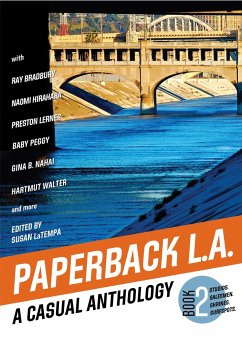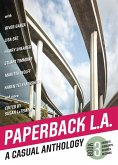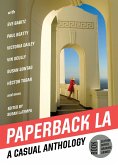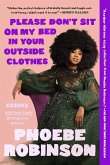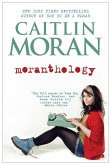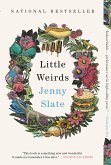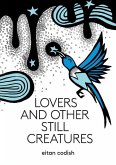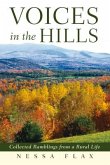Paperback L.A. Book 2: A Casual Anthology: Studios, Salesmen, Shrines, Surfspots
Herausgeber: Latempa, Susan
18,99 €
inkl. MwSt.
Versandfertig in über 4 Wochen

9 °P sammeln
Paperback L.A. Book 2: A Casual Anthology: Studios, Salesmen, Shrines, Surfspots
Herausgeber: Latempa, Susan
- Broschiertes Buch
- Merkliste
- Auf die Merkliste
- Bewerten Bewerten
- Teilen
- Produkt teilen
- Produkterinnerung
- Produkterinnerung
The casual anthology L.A. has been waiting for, rich with insight, humor, personality, history, modernity, and great writers old and new.
Andere Kunden interessierten sich auch für
![Paperback L.A. Book 3 Paperback L.A. Book 3]() Paperback L.A. Book 318,99 €
Paperback L.A. Book 318,99 €![Paperback L.A. Book 1 Paperback L.A. Book 1]() Paperback L.A. Book 118,99 €
Paperback L.A. Book 118,99 €![Please Don't Sit on My Bed in Your Outside Clothes Please Don't Sit on My Bed in Your Outside Clothes]() Phoebe RobinsonPlease Don't Sit on My Bed in Your Outside Clothes15,99 €
Phoebe RobinsonPlease Don't Sit on My Bed in Your Outside Clothes15,99 €![Moranthology Moranthology]() Caitlin MoranMoranthology18,99 €
Caitlin MoranMoranthology18,99 €![Little Weirds Little Weirds]() Jenny SlateLittle Weirds17,99 €
Jenny SlateLittle Weirds17,99 €![Lovers and Other Still Creatures Lovers and Other Still Creatures]() Eitan CodishLovers and Other Still Creatures16,99 €
Eitan CodishLovers and Other Still Creatures16,99 €![Voices in the Hills: Collected Ramblings from a Rural Life Voices in the Hills: Collected Ramblings from a Rural Life]() Nessa FlaxVoices in the Hills: Collected Ramblings from a Rural Life20,99 €
Nessa FlaxVoices in the Hills: Collected Ramblings from a Rural Life20,99 €-
-
-
The casual anthology L.A. has been waiting for, rich with insight, humor, personality, history, modernity, and great writers old and new.
Hinweis: Dieser Artikel kann nur an eine deutsche Lieferadresse ausgeliefert werden.
Hinweis: Dieser Artikel kann nur an eine deutsche Lieferadresse ausgeliefert werden.
Produktdetails
- Produktdetails
- Paperback L.A. Nr.2
- Verlag: Turner Publishing Company
- Seitenzahl: 152
- Erscheinungstermin: 30. Oktober 2018
- Englisch
- Abmessung: 231mm x 168mm x 18mm
- Gewicht: 454g
- ISBN-13: 9781945551376
- ISBN-10: 1945551372
- Artikelnr.: 50910923
- Herstellerkennzeichnung
- Libri GmbH
- Europaallee 1
- 36244 Bad Hersfeld
- gpsr@libri.de
- Paperback L.A. Nr.2
- Verlag: Turner Publishing Company
- Seitenzahl: 152
- Erscheinungstermin: 30. Oktober 2018
- Englisch
- Abmessung: 231mm x 168mm x 18mm
- Gewicht: 454g
- ISBN-13: 9781945551376
- ISBN-10: 1945551372
- Artikelnr.: 50910923
- Herstellerkennzeichnung
- Libri GmbH
- Europaallee 1
- 36244 Bad Hersfeld
- gpsr@libri.de
Susan LaTempa is a Los Angeles editor. At LA Style, West Coast Plays, Padua Hills Theater Festival, Westways, The Los Angeles Times, and Liberty Hill Foundation, she's worked with journalists, playwrights, novelists, recipe developers, landscapers, photographers, and videographers. She's concentrated on addressing L.A.'s vast, cosmopolitan audiences, in the process helping shape dozens of memorable articles, reviews, memoirs, parodies, essays, theater pieces, and videos that have illuminated so many aspects of L.A.
LA's first stoner party Memoirs of a
Merchant......................................Jose Arnaz.
What happens when Don Abel Stearns hosts early LA's first invitation-only
social gathering? An excerpt from "Memoirs of a Merchant" dictated by Jose
Arnaz to Bancroft Library. Translated and edited by Nellie Van de Grift
Sanchez.
Ghost Town #1: Terminal Island: Lost Communities of Los Angeles
Harbor..................Naomi Hirahara
Highlights from the award-winning book on the fascinating mix of successive
settlements on a sheltered coast, as fish-shack hermits gave way to
Victorian lady shell experts who were followed by Bohemian artist squatters
and then Japanese American fishing families.
Nature Notes #1 Harvesting Wild Mustard........................H. E.
Lougheed
"Until the 'eighties, Southern California was a land of wild mustard
fields." The author means the 1880s, as he describes in this 1951 account
his father's 1890 decision to get out of the wild mustard business.
A Star Feels
Guilty............................................................................Diana
Serra Cary
In excerpts from her illuminating 1978 book Hollywood's Children, An Inside
Account of the Child Star Era, one of the biggest child stars of all time
tells a nuanced story of exploitation and need, glamor and danger. She
interviews and name-checks Judy Garland, Jackie Coogan, >/i>'s Billie
"Buckwheat" Thomas and the many others. Cary starred as Baby Peggy in
two-reel comedies at the age of 20 months in 1921.
The Need for Speed! LA's Auto Racing Legacy: A
Timeline..............................................................................Preston
Lerner
A fast, furious look at more than 100 years racing milestones: From the
winning 64 mph at LA's first official race in 1909 to the amazing 171 mph
on a dry lake in 1927 by a Miller 91 race car. From the 1920s birth of
hot-rodding when young mechanics modified Model Ts to the 1999 birth of
rat-rodding. From the 1937 demise of the Killer Track (Legion Ascot in
Lincoln Heights) to the 2008 opening of the first Tesla showroom in the
county. And much more.
Ghost Town #2: Central Avenue (Photo Essay)
The Shades of LA collection has an incredible number of Central Avenue
photos taken from family albums. May be coupled with quotes from a book
called Swingin' on Central Avenue: African American Jazz in Los Angeles.
Homage, Memoir or
Misguided?..........................................................................Ray
Bradbury
Widely panned when published in 1999 when Bradbury was 79, Death is a
Lonely Business seems intended as a spoof of LA's most famous literary
genre, the hard-boiled mystery. But it works better in many ways as a
fever-dream memoir of the author's time when a young writer living on the
cheap in early 50s Venice before he became, you know, Ray Bradbury.
Nature Note #2,
Avocados...........................................................................Helen
Brown
An explanation from California best-regarded cookbook author of the postwar
era. From West Coast Cookbook (1952)
My Father's Malibu, My Mother's Griffith
Park.....................................................Colleen Dunn
Bates, Eric Gutierrez
Two delightful takes on the once-removed memoir as writers describe what
they have heard and know about significantly hip landmarks in a parent's
life in Los Angeles: the Malibu surf scene of the 1950s and love-ins (well,
"happenings") in 1968 Griffith Park.
Photo Essay: "La Cuidad"..........................................Danny
Martinez
Scheherazade in
LA.......................................................Gina B. Nahai
This selection is from Moonlight on the Avenue of Faith (1999), an LA Times
bestseller and a compellingly funny, frank and complex novel of the Persian
Jewish diaspora. It captures the mythic energy and determination of a young
immigrant's aunt who, in her way, sets Beverly Hills afire.
One-Liners Centerfold: What Do You Have to Do to Get a Street Named for You
in LA?
......................................................................................Charles
P. Hobbs
From the transit historian and systems librarian at Compton College.
Summers in the
Cities......................................................................................Patricia
Freeman
In the late 1980s, one of LA's favorite magazines was LA Style, where long
stories by some of the city's poorest writers met giant pictures by some of
the country's fanciest fashion photogs. This knowing and memorable
comparison of LA and New York in August is from a monthly column called
NY/LA/LA/NY.
Geography
Warp......................................................................................Karen
Tei
It all starts to make sense if you read it, and there's tremendous color
and interest in the telling. From Mazatlan, Mexico, events and characters
are set in motion mysteriously circling LA until a traffic disaster on the
Harbor Freeway becomes the heart of the hemisphere. Homeless people take up
residents in abandoned vehicles while a Sansei musician named Manzanar
Murakami conducts his orchestra from the overpass. From the 1997 novel
Tropic of Orange.
Two Fugly
Buildings......................................................................................Wendy
Gilmartin
For several years on her blog for LA Weekly, Gilmartin wrote about her pet
fugly buildings with affection and awe. As she told an interviewer for LA
Forum for Architecture and Urban Design, "I do love the buildings I write
about. I think there is something special about each of them. Ugly
buildings and fancy architecture are two very different things." "The Bank
that Looks Like Del Taco" and "The Zipper on a Pantsuit: Harmony Gold
Theater & Offices" are reprinted here in their entirety.
Nature Note #3: Photo Essay Shorebirds of Malibu and La
Ballona......................................................................................Harmut
Walter
Merchant......................................Jose Arnaz.
What happens when Don Abel Stearns hosts early LA's first invitation-only
social gathering? An excerpt from "Memoirs of a Merchant" dictated by Jose
Arnaz to Bancroft Library. Translated and edited by Nellie Van de Grift
Sanchez.
Ghost Town #1: Terminal Island: Lost Communities of Los Angeles
Harbor..................Naomi Hirahara
Highlights from the award-winning book on the fascinating mix of successive
settlements on a sheltered coast, as fish-shack hermits gave way to
Victorian lady shell experts who were followed by Bohemian artist squatters
and then Japanese American fishing families.
Nature Notes #1 Harvesting Wild Mustard........................H. E.
Lougheed
"Until the 'eighties, Southern California was a land of wild mustard
fields." The author means the 1880s, as he describes in this 1951 account
his father's 1890 decision to get out of the wild mustard business.
A Star Feels
Guilty............................................................................Diana
Serra Cary
In excerpts from her illuminating 1978 book Hollywood's Children, An Inside
Account of the Child Star Era, one of the biggest child stars of all time
tells a nuanced story of exploitation and need, glamor and danger. She
interviews and name-checks Judy Garland, Jackie Coogan, >/i>'s Billie
"Buckwheat" Thomas and the many others. Cary starred as Baby Peggy in
two-reel comedies at the age of 20 months in 1921.
The Need for Speed! LA's Auto Racing Legacy: A
Timeline..............................................................................Preston
Lerner
A fast, furious look at more than 100 years racing milestones: From the
winning 64 mph at LA's first official race in 1909 to the amazing 171 mph
on a dry lake in 1927 by a Miller 91 race car. From the 1920s birth of
hot-rodding when young mechanics modified Model Ts to the 1999 birth of
rat-rodding. From the 1937 demise of the Killer Track (Legion Ascot in
Lincoln Heights) to the 2008 opening of the first Tesla showroom in the
county. And much more.
Ghost Town #2: Central Avenue (Photo Essay)
The Shades of LA collection has an incredible number of Central Avenue
photos taken from family albums. May be coupled with quotes from a book
called Swingin' on Central Avenue: African American Jazz in Los Angeles.
Homage, Memoir or
Misguided?..........................................................................Ray
Bradbury
Widely panned when published in 1999 when Bradbury was 79, Death is a
Lonely Business seems intended as a spoof of LA's most famous literary
genre, the hard-boiled mystery. But it works better in many ways as a
fever-dream memoir of the author's time when a young writer living on the
cheap in early 50s Venice before he became, you know, Ray Bradbury.
Nature Note #2,
Avocados...........................................................................Helen
Brown
An explanation from California best-regarded cookbook author of the postwar
era. From West Coast Cookbook (1952)
My Father's Malibu, My Mother's Griffith
Park.....................................................Colleen Dunn
Bates, Eric Gutierrez
Two delightful takes on the once-removed memoir as writers describe what
they have heard and know about significantly hip landmarks in a parent's
life in Los Angeles: the Malibu surf scene of the 1950s and love-ins (well,
"happenings") in 1968 Griffith Park.
Photo Essay: "La Cuidad"..........................................Danny
Martinez
Scheherazade in
LA.......................................................Gina B. Nahai
This selection is from Moonlight on the Avenue of Faith (1999), an LA Times
bestseller and a compellingly funny, frank and complex novel of the Persian
Jewish diaspora. It captures the mythic energy and determination of a young
immigrant's aunt who, in her way, sets Beverly Hills afire.
One-Liners Centerfold: What Do You Have to Do to Get a Street Named for You
in LA?
......................................................................................Charles
P. Hobbs
From the transit historian and systems librarian at Compton College.
Summers in the
Cities......................................................................................Patricia
Freeman
In the late 1980s, one of LA's favorite magazines was LA Style, where long
stories by some of the city's poorest writers met giant pictures by some of
the country's fanciest fashion photogs. This knowing and memorable
comparison of LA and New York in August is from a monthly column called
NY/LA/LA/NY.
Geography
Warp......................................................................................Karen
Tei
It all starts to make sense if you read it, and there's tremendous color
and interest in the telling. From Mazatlan, Mexico, events and characters
are set in motion mysteriously circling LA until a traffic disaster on the
Harbor Freeway becomes the heart of the hemisphere. Homeless people take up
residents in abandoned vehicles while a Sansei musician named Manzanar
Murakami conducts his orchestra from the overpass. From the 1997 novel
Tropic of Orange.
Two Fugly
Buildings......................................................................................Wendy
Gilmartin
For several years on her blog for LA Weekly, Gilmartin wrote about her pet
fugly buildings with affection and awe. As she told an interviewer for LA
Forum for Architecture and Urban Design, "I do love the buildings I write
about. I think there is something special about each of them. Ugly
buildings and fancy architecture are two very different things." "The Bank
that Looks Like Del Taco" and "The Zipper on a Pantsuit: Harmony Gold
Theater & Offices" are reprinted here in their entirety.
Nature Note #3: Photo Essay Shorebirds of Malibu and La
Ballona......................................................................................Harmut
Walter
LA's first stoner party Memoirs of a
Merchant......................................Jose Arnaz.
What happens when Don Abel Stearns hosts early LA's first invitation-only
social gathering? An excerpt from "Memoirs of a Merchant" dictated by Jose
Arnaz to Bancroft Library. Translated and edited by Nellie Van de Grift
Sanchez.
Ghost Town #1: Terminal Island: Lost Communities of Los Angeles
Harbor..................Naomi Hirahara
Highlights from the award-winning book on the fascinating mix of successive
settlements on a sheltered coast, as fish-shack hermits gave way to
Victorian lady shell experts who were followed by Bohemian artist squatters
and then Japanese American fishing families.
Nature Notes #1 Harvesting Wild Mustard........................H. E.
Lougheed
"Until the 'eighties, Southern California was a land of wild mustard
fields." The author means the 1880s, as he describes in this 1951 account
his father's 1890 decision to get out of the wild mustard business.
A Star Feels
Guilty............................................................................Diana
Serra Cary
In excerpts from her illuminating 1978 book Hollywood's Children, An Inside
Account of the Child Star Era, one of the biggest child stars of all time
tells a nuanced story of exploitation and need, glamor and danger. She
interviews and name-checks Judy Garland, Jackie Coogan, >/i>'s Billie
"Buckwheat" Thomas and the many others. Cary starred as Baby Peggy in
two-reel comedies at the age of 20 months in 1921.
The Need for Speed! LA's Auto Racing Legacy: A
Timeline..............................................................................Preston
Lerner
A fast, furious look at more than 100 years racing milestones: From the
winning 64 mph at LA's first official race in 1909 to the amazing 171 mph
on a dry lake in 1927 by a Miller 91 race car. From the 1920s birth of
hot-rodding when young mechanics modified Model Ts to the 1999 birth of
rat-rodding. From the 1937 demise of the Killer Track (Legion Ascot in
Lincoln Heights) to the 2008 opening of the first Tesla showroom in the
county. And much more.
Ghost Town #2: Central Avenue (Photo Essay)
The Shades of LA collection has an incredible number of Central Avenue
photos taken from family albums. May be coupled with quotes from a book
called Swingin' on Central Avenue: African American Jazz in Los Angeles.
Homage, Memoir or
Misguided?..........................................................................Ray
Bradbury
Widely panned when published in 1999 when Bradbury was 79, Death is a
Lonely Business seems intended as a spoof of LA's most famous literary
genre, the hard-boiled mystery. But it works better in many ways as a
fever-dream memoir of the author's time when a young writer living on the
cheap in early 50s Venice before he became, you know, Ray Bradbury.
Nature Note #2,
Avocados...........................................................................Helen
Brown
An explanation from California best-regarded cookbook author of the postwar
era. From West Coast Cookbook (1952)
My Father's Malibu, My Mother's Griffith
Park.....................................................Colleen Dunn
Bates, Eric Gutierrez
Two delightful takes on the once-removed memoir as writers describe what
they have heard and know about significantly hip landmarks in a parent's
life in Los Angeles: the Malibu surf scene of the 1950s and love-ins (well,
"happenings") in 1968 Griffith Park.
Photo Essay: "La Cuidad"..........................................Danny
Martinez
Scheherazade in
LA.......................................................Gina B. Nahai
This selection is from Moonlight on the Avenue of Faith (1999), an LA Times
bestseller and a compellingly funny, frank and complex novel of the Persian
Jewish diaspora. It captures the mythic energy and determination of a young
immigrant's aunt who, in her way, sets Beverly Hills afire.
One-Liners Centerfold: What Do You Have to Do to Get a Street Named for You
in LA?
......................................................................................Charles
P. Hobbs
From the transit historian and systems librarian at Compton College.
Summers in the
Cities......................................................................................Patricia
Freeman
In the late 1980s, one of LA's favorite magazines was LA Style, where long
stories by some of the city's poorest writers met giant pictures by some of
the country's fanciest fashion photogs. This knowing and memorable
comparison of LA and New York in August is from a monthly column called
NY/LA/LA/NY.
Geography
Warp......................................................................................Karen
Tei
It all starts to make sense if you read it, and there's tremendous color
and interest in the telling. From Mazatlan, Mexico, events and characters
are set in motion mysteriously circling LA until a traffic disaster on the
Harbor Freeway becomes the heart of the hemisphere. Homeless people take up
residents in abandoned vehicles while a Sansei musician named Manzanar
Murakami conducts his orchestra from the overpass. From the 1997 novel
Tropic of Orange.
Two Fugly
Buildings......................................................................................Wendy
Gilmartin
For several years on her blog for LA Weekly, Gilmartin wrote about her pet
fugly buildings with affection and awe. As she told an interviewer for LA
Forum for Architecture and Urban Design, "I do love the buildings I write
about. I think there is something special about each of them. Ugly
buildings and fancy architecture are two very different things." "The Bank
that Looks Like Del Taco" and "The Zipper on a Pantsuit: Harmony Gold
Theater & Offices" are reprinted here in their entirety.
Nature Note #3: Photo Essay Shorebirds of Malibu and La
Ballona......................................................................................Harmut
Walter
Merchant......................................Jose Arnaz.
What happens when Don Abel Stearns hosts early LA's first invitation-only
social gathering? An excerpt from "Memoirs of a Merchant" dictated by Jose
Arnaz to Bancroft Library. Translated and edited by Nellie Van de Grift
Sanchez.
Ghost Town #1: Terminal Island: Lost Communities of Los Angeles
Harbor..................Naomi Hirahara
Highlights from the award-winning book on the fascinating mix of successive
settlements on a sheltered coast, as fish-shack hermits gave way to
Victorian lady shell experts who were followed by Bohemian artist squatters
and then Japanese American fishing families.
Nature Notes #1 Harvesting Wild Mustard........................H. E.
Lougheed
"Until the 'eighties, Southern California was a land of wild mustard
fields." The author means the 1880s, as he describes in this 1951 account
his father's 1890 decision to get out of the wild mustard business.
A Star Feels
Guilty............................................................................Diana
Serra Cary
In excerpts from her illuminating 1978 book Hollywood's Children, An Inside
Account of the Child Star Era, one of the biggest child stars of all time
tells a nuanced story of exploitation and need, glamor and danger. She
interviews and name-checks Judy Garland, Jackie Coogan, >/i>'s Billie
"Buckwheat" Thomas and the many others. Cary starred as Baby Peggy in
two-reel comedies at the age of 20 months in 1921.
The Need for Speed! LA's Auto Racing Legacy: A
Timeline..............................................................................Preston
Lerner
A fast, furious look at more than 100 years racing milestones: From the
winning 64 mph at LA's first official race in 1909 to the amazing 171 mph
on a dry lake in 1927 by a Miller 91 race car. From the 1920s birth of
hot-rodding when young mechanics modified Model Ts to the 1999 birth of
rat-rodding. From the 1937 demise of the Killer Track (Legion Ascot in
Lincoln Heights) to the 2008 opening of the first Tesla showroom in the
county. And much more.
Ghost Town #2: Central Avenue (Photo Essay)
The Shades of LA collection has an incredible number of Central Avenue
photos taken from family albums. May be coupled with quotes from a book
called Swingin' on Central Avenue: African American Jazz in Los Angeles.
Homage, Memoir or
Misguided?..........................................................................Ray
Bradbury
Widely panned when published in 1999 when Bradbury was 79, Death is a
Lonely Business seems intended as a spoof of LA's most famous literary
genre, the hard-boiled mystery. But it works better in many ways as a
fever-dream memoir of the author's time when a young writer living on the
cheap in early 50s Venice before he became, you know, Ray Bradbury.
Nature Note #2,
Avocados...........................................................................Helen
Brown
An explanation from California best-regarded cookbook author of the postwar
era. From West Coast Cookbook (1952)
My Father's Malibu, My Mother's Griffith
Park.....................................................Colleen Dunn
Bates, Eric Gutierrez
Two delightful takes on the once-removed memoir as writers describe what
they have heard and know about significantly hip landmarks in a parent's
life in Los Angeles: the Malibu surf scene of the 1950s and love-ins (well,
"happenings") in 1968 Griffith Park.
Photo Essay: "La Cuidad"..........................................Danny
Martinez
Scheherazade in
LA.......................................................Gina B. Nahai
This selection is from Moonlight on the Avenue of Faith (1999), an LA Times
bestseller and a compellingly funny, frank and complex novel of the Persian
Jewish diaspora. It captures the mythic energy and determination of a young
immigrant's aunt who, in her way, sets Beverly Hills afire.
One-Liners Centerfold: What Do You Have to Do to Get a Street Named for You
in LA?
......................................................................................Charles
P. Hobbs
From the transit historian and systems librarian at Compton College.
Summers in the
Cities......................................................................................Patricia
Freeman
In the late 1980s, one of LA's favorite magazines was LA Style, where long
stories by some of the city's poorest writers met giant pictures by some of
the country's fanciest fashion photogs. This knowing and memorable
comparison of LA and New York in August is from a monthly column called
NY/LA/LA/NY.
Geography
Warp......................................................................................Karen
Tei
It all starts to make sense if you read it, and there's tremendous color
and interest in the telling. From Mazatlan, Mexico, events and characters
are set in motion mysteriously circling LA until a traffic disaster on the
Harbor Freeway becomes the heart of the hemisphere. Homeless people take up
residents in abandoned vehicles while a Sansei musician named Manzanar
Murakami conducts his orchestra from the overpass. From the 1997 novel
Tropic of Orange.
Two Fugly
Buildings......................................................................................Wendy
Gilmartin
For several years on her blog for LA Weekly, Gilmartin wrote about her pet
fugly buildings with affection and awe. As she told an interviewer for LA
Forum for Architecture and Urban Design, "I do love the buildings I write
about. I think there is something special about each of them. Ugly
buildings and fancy architecture are two very different things." "The Bank
that Looks Like Del Taco" and "The Zipper on a Pantsuit: Harmony Gold
Theater & Offices" are reprinted here in their entirety.
Nature Note #3: Photo Essay Shorebirds of Malibu and La
Ballona......................................................................................Harmut
Walter
